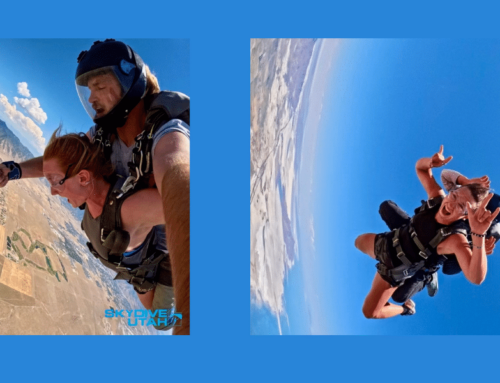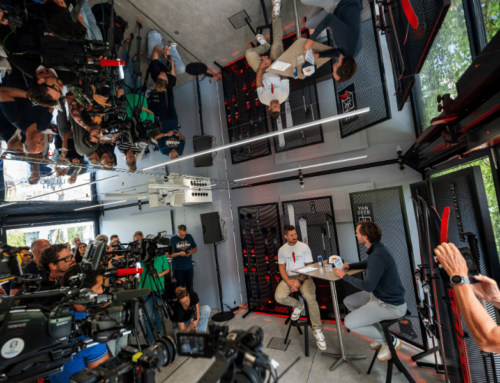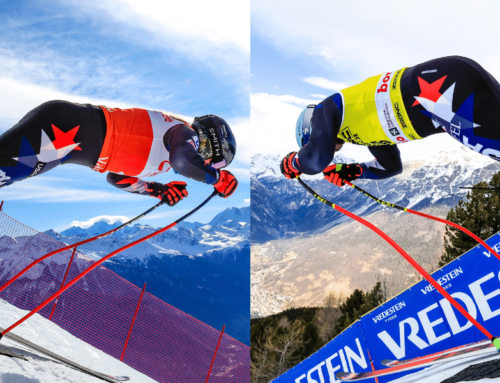Inside the Norwegian Men’s Speed Team: Injuries, Recovery and Future Prospects
The Norwegian men’s speed team has captured over a third of the World Cup speed discipline globes in the past 20 years, including Aleksander Aamodt Kilde’s three globes during the past two seasons. However, no Norwegian men started this year in the World Cup Finals’ super-G and downhill events. Ski Racing Media looks at the small but mighty team, including what Aamodt Kilde and Mikaela Shiffrin said during the World Cup Finals about his recovery from serious injuries.
It is hard to say who lit up their surroundings the most: the Attacking Vikings’ team cornerstone Aamodt Kilde, girlfriend and powerhouse racer Shiffrin, or the sun beaming down on Saalbach-Hinterglemm before the final women’s downhill competition of the 2024 season.
Aamodt Kilde has undergone several rounds of surgery, a complicated healing process and challenging rehabilitation training, which has finally enabled him to walk instead of sitting in a wheelchair. He sustained severe injuries during a crash and forceful impact with a safety fence right before the finish line at the Lauberhorn downhill in Wengen, Switzerland, on January 13.
During the World Cup Finals, Aamodt Kilde joined the World Cup skiing family again, this time as a spectator.
Experiencing the World Cup vibe
He stood together with Shiffrin in the Saalbach, Austria, finish area as Shiffrin’s injuries kept her from racing in all but the slalom competition at the World Cup Finals. She took home the slalom victory on March 16 and the World Cup slalom discipline globe.
In a March 23 interview with reporter Christian Paasche from Norwegian broadcaster TV2, Aamodt Kilde and Shiffrin shared emotions and status updates.
“It’s quite emotional to be here, to be honest. I sense the feeling that there is a long way to go until I can ski, but it’s very cool to just feel the vibe and see Mikaela and see people you’re used to seeing,” Aamodt Kilde said. “I’m really ready to just enjoy the day and feel that it’s nice to be on my feet again, to be able to do things myself.”
Shiffrin’s important presence
Aamodt Kilde told TV2 about the importance of having Shiffrin close by after his accident:
“She’s meant the world, actually, being in a situation where you are vulnerable, and you can’t do anything.”
Click on images to enlarge
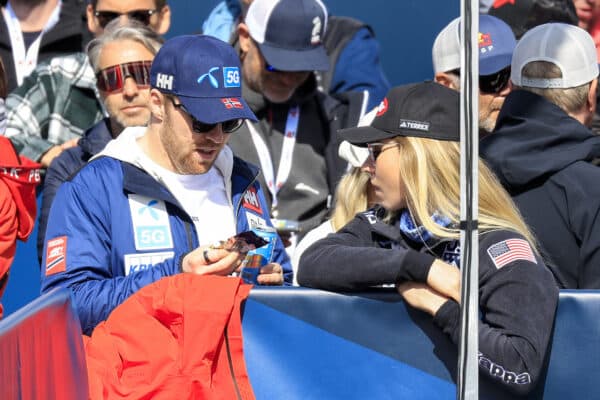
The powerfully built ski racer, who suddenly was incapacitated, talked about the first night after his accident when he woke up in the hospital: “I didn’t know if people knew what I was doing and where I was. So, my first thought when I woke up was, ‘I need to call everybody and let them know what’s happening,’ even though I didn’t know. And then Mikaela was there. At that moment, it just meant everything in that situation.
“We had one night together, and she was actually sleeping on the floor,” Aamodt Kilde continued with a laugh. “I was in pain, but it was kind of peaceful. I kept waking up, looking at her and having a good feeling that she was there. We could have a good moment in a tough moment as well,” Aamodt Kilde told TV2.
After sustaining her injury two weeks later, Shiffrin could do her rehabilitation training at the same location as Aamodt Kilde: BASEFIVE in his current hometown, Innsbruck, Austria.
“I do my best to keep his spirits up, but I think he does that more for me than anything,” she said happily before updating TV2 on her injury recovery to continue after the World Cup Finals:
“My ankle’s still swelling, my knee’s still swelling. There’s still sometimes—not pain, but it’s not perfect, so I have to get a jumpstart on the prep season and take some recovery now.”
Uncertain path ahead
Aamodt Kilde has a long way to go in his rehabilitation process and is uncertain whether he can return to World Cup ski racing. He has shared progress and physical and mental hardship in social media updates and interviews. At the World Cup Finals, he described the ongoing process to TV2:
“I can’t quite imagine skiing yet. I think that’s perfectly fine, and it’s not something I need to decide on yet. But I really, really want to have that as a goal. And then, when I get skis on my feet, I can answer whether it works or not. But right now, there’s a little work to be done, to be completely honest,” the world-class ski racer said.
The shoulder he dislocated is still stiff and will require more rehabilitation. It has yet to be determined whether the racer renowned for his powerful starts will once again be able to propel himself energetically with his poles and gain valuable speed on the racecourses.
The nerve damage caused by the deep cut sustained in his leg leaves parts of his lower leg and foot numb. He cannot lift his big toe; it just hangs down from his foot when it does not have support. Not only is this troublesome and uncomfortable in everyday life but the sensation and ability to apply or release pressure in different parts of your feet and toes are essential in fine-tuned, world-class alpine ski racing.
Teammate Sejersted also injured
In addition to Aamodt Kilde, teammate Adrian Smiseth Sejersted also sustained a season-ending injury this year. Sejersted and Aamodt Kilde qualified to compete at the World Cup Finals but could not start.
Sejersted crashed during an official World Cup downhill training run at Kvitfjell, Norway, on February 16. He missed the preferred line in a significant turn and over the following jump, landing outside the ideal line, where the snow was softer. His feet stalled, and he tumbled forward several times during the significant fall and hit the safety net—the result: a dislocated shoulder and surgery.

Career highlights
Sejersted won the 2014 FIS Junior World Ski Championship in downhill, qualifying him for his first World Cup start at the Finals only days later. His older sister, Lotte Smiseth Sejersted, only weeks earlier, finished sixth in the 2014 Olympic downhill. She had already captured four FIS Junior World Ski Championship medals, including the 2011 downhill gold. After several seasons with injuries, one of Norway’s most talented female skiers retired in 2017.
Younger brother Sejersted earned 19 top-10 results during his first ten years in the World Cup: 14 in super-G and five in downhill. In December 2020, he podiumed twice in super-G. In the 2023 and 2019 super-G World Championships, he finished 7th and 8th, respectively.
The skier from Stabæk IF sports club near Oslo, Norway, has also had strong results during the past two seasons. He placed 5th in the 2023 Kitzbühel downhill and 6th in the two 2024 Garmisch-Partenkirchen super-Gs.
Sejersted’s 4th-place finish in this year’s Lauberhorn downhill in Wengen stands out as particularly impressive. Following teammate Aamodt Kilde’s serious accident, the race officials had to stop the race for almost 30 minutes to provide treatment to the injured Norwegian and arrange a helicopter rescue from the finish area.
This was a challenging situation for everyone, including the athletes at the start, who were waiting to race. Sejersted showed immense mental strength and delivered solid skiing, earning him his best result this season. Afterward, he had a hard time finding words during a finish area interview with Norwegian broadcaster NRK:
“(This is) a very special day, one of my tougher downhill days. It brings to life quite strong emotions when things go both well and badly.”
Hunting podiums
During the 2022 Olympic Winter Games super-G competition, Sejersted started 7th and skied into second place behind leading teammate Aamodt Kilde. The Norwegian skiing community was in suspense, hoping Sejersted would win a medal. He has battled many injuries and knee problems throughout the years, negatively affecting his career.
However, Austrian Matthias Mayer, wearing bib 13, skied into first place on the Beijing super-G course soon after. Next, with bib 14, Ryan Cochran-Siegle captured the silver medal, moving Aamodt Kilde into third place and Sejersted off the podium into fourth place, only 0.32 seconds out of a bronze medal.
Sejersted’s results over time show that he is close to the top. During the March 2023 Aspen World Cup downhill, he maintained the lead from bib number one until the race was canceled just before 30 competitors had started. Snow and fog moved in, and the jury canceled the race. For the World Cup results to be valid, a minimum of 30 athletes must have started in a competition.
Once again, disappointment engulfed Sejersted while Norwegian skiing fans shed tears on his behalf. Welcome to the world of ski racing, where various external factors beyond the athletes’ control can significantly influence race results at any moment.
I’ll be back
Despite needing surgery after this year’s injury, Sejersted is motivated to train hard and return next season.
“If I had fallen after the somewhat slow start in Val Gardena and Bormio, then perhaps the answer would’ve been completely different. But the results I got in January make me confident that I have good speed, and that gives me the motivation to keep going,” Sejersted told his local newspaper Budstikka the week after his Kvitfjell crash.
Budstikka reported on February 20 that the 29-year-old is determined to continue training hard and racing for several seasons, with the 2026 Olympic Winter Games as a clear goal.
Newcomer Fredrik Møller
Some younger Norwegian national team racers have joined Aamodt Kilde and Sejersted at World Cup speed events during past seasons. One of them is Fredrik Møller, who enjoyed his World Cup debut this season.
Møller’s parents, both former ski racers, moved the family from Bærum near Oslo to the rural town of Oppdal, Norway, when Fredrik and his sister Pia were young. This ensured the ski-loving family easy access to a larger ski area with long winters and excellent training opportunities for the two siblings.
Growing up in the small, outdoorsy town by the mountains bore fruit. During his first World Cup season, the 23-year-old impressively scored points in all three disciplines, placing 21st in super-G, two times 24th in giant slalom, and 30th in downhill. He started in 16 World Cup competitions and nine European Cup races during the 2024 season.
Møller stems from the strong Oppdal Alpin ski club and Oppdal Alpin Elite training program. Oppdal Alpine Elite cooperates with the Oppdal public secondary school. It has fostered many great skiers, including national team members Timon Haugan, Alexander Steen Olsen, Thea Louise Stjernesund, Bianca Bakke Westhoff and Markus Nordgård Fossland, as well as icons Aksel Lund Svindal and Ragnhild Mowinckel.
Positive experiences
Møller talked with Ski Racing about his first World Cup season during the Kvitfjell speed events in mid-February.
In his first World Cup start, the Sölden giant slalom opener, he placed 21st in the first run after solid skiing. Unfortunately, the second run was canceled due to strong winds. Møller told Ski Racing the experience still was positive, as it proved he could compete at the World Cup level.
He continued with good skiing in several of the following races, while other World Cup events felt rougher. Møller gained positive experiences out of those situations as well:
“In GS, I have been pretty close to qualifying (for the second run) even if (my skiing) felt bad, or I didn’t ski my best. So, it has been positive that I’ve been so close and still felt that I didn’t utilize my full potential. But that’s easier said than done to bring out that potential,” Møller smiled.
“No matter how good you are, I believe there are always ups and downs in this sport. There are small margins that decide how much time you lose. It is important to just keep on working,” he added.
Favorite discipline
Møller races three disciplines. Which one is his favorite?
“Usually, whichever works the best is the most fun,” he said, laughing while standing in the Kvitfjell World Cup finish area.
“Right now, I train a lot of giant slalom; I train very little speed, really. There is little time for that, since I race a lot of European Cup and World Cup.”
He believes “all training is good training” and that there will be more focus on speed in the future. “I might have a bit greater potential there than in giant slalom,” he added humbly.
After placing 30th in the downhill the previous day, Møller finished 34th in the Kvitfjell World Cup super-G race right before our talk. He was not pleased with the top section of his run and finished 0.17 seconds out of the points.
“I will come back stronger,” he stated, soft-spoken yet determined.
On March 22, Møller finished 4th in super-G at the European Cup Finals in Kvitfjell, only 0.09 seconds behind the top spot.
Injury break for Fossland
Markus Nordgård Fossland qualified for the national team in 2022 and has competed in the speed disciplines in the World Cup and European Cup for several years.
This winter, he suffered a skeletal injury during a crash at the January 13 Lauberhorn downhill race, where Aamodt Kilde also suffered his accident. The injury stopped Fossland from competing in Kitzbühel the following week. After a short injury break, the 25-year-old returned to the super-G and downhill World Cup competitions at Kvitfjell in mid-February.
Fossland has been a determined skier since an early age. According to an interview with the Norwegian newspaper Aftenposten in 2022, Fossland asked his father to teach him to cook dinner when he was a little boy. His father, a former alpine ski racer, asked his son why. Eight-nine-year-old Markus responded that he had heard of a school in Oppdal where you could both attend school and ski simultaneously, and he knew he would have to move there alone. Later, Fossland moved away from home to attend the Oppdal secondary school and train with Oppdal Alpin Elite.
Fossland, originally from Stjørdal, Norway (located a couple of hours west of Åre, Sweden), has had 26 World Cup starts since his World Cup debut in December 2021. In addition, he has had 48 European Cup starts since March 2018, with six top-10 results, including one victory in the speed events.
Small speed teams
The Norwegian national speed teams for men and women are typically relatively small, often with only two or three athletes for each gender. Hence, the teams are vulnerable to athletes’ injuries or retirement.
Now headed by Kajsa Vickhoff Lie, the women’s speed team will have to build for the future without recently retired Ragnhild Mowinckel.
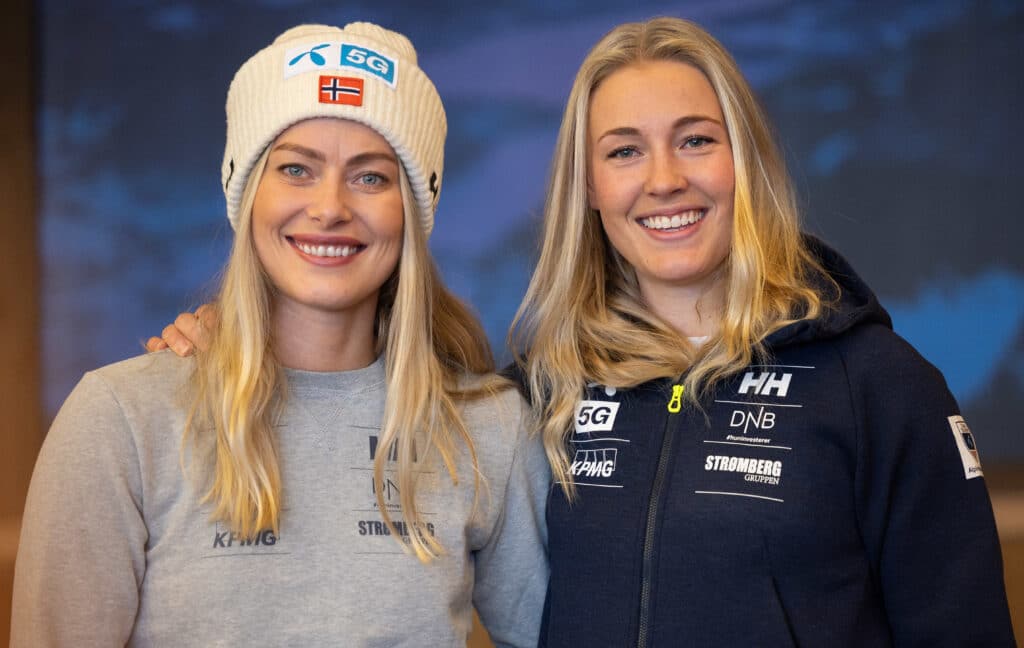
Everyone in the skiing community hopes Aamodt Kilde will recover from his injuries so he can lead a pain-free everyday life. Hopefully, he will also be able to return as a World Cup ski racer. The rehabilitation process will have to take whatever time is needed.
In addition to recovering from his injuries, Aamodt Kilde previously expressed his desire not to return to ski racing unless changes are made within the Norwegian Ski Federation. A long-lasting conflict regarding the Norwegian alpine skiers’ marketing rights has yet to be solved. Aamodt Kilde did not mention this aspect during his recent interview with TV2 in Saalbach.
Viking globe winners
Despite the Norwegian Ski Federation’s small speed-discipline teams, the Norwegian men have captured unprecedented World Cup globes.
Over the past 20 years, 2005-2024, speed racers Aamodt Kilde, Kjetil Jansrud and Aksel Lund Svindal have won ten super-G and five downhill World Cup discipline globes, more than a third of the globes awarded in the men’s speed disciplines since 2005.

Additionally, Aamodt Kilde won the overall globe in 2020. Svindal captured the overall title in 2009 and the overall giant slalom and combined globes in 2007.
Furthermore, Aamodt Kilde, Jansrud and Svindal recorded 20 second-place and third-place finishes in the World Cup overall and speed discipline standings between 2005-2024. Also, top-3 results in the technical discipline standings and results before 2005 can be added to the Norwegian men’s list of accomplishments.
The future of Norwegian men’s speed team
With the top-two speed racers injured, Aamodt Kilde’s uncertainties, and no Norwegian men starting in the speed events at the World Cup Finals, the future might seem bleak. Still, the future can be promising for the Attacking Vikings:
During a conversation with Ski Racing on February 18, Claus Ryste, the alpine director for the Norwegian Alpine Team, highlighted that Sejersted is expected to return quickly after his shoulder injury. The alpine director noted that Møller showed potential in his first World Cup season.
The Norwegian Alpine Team traditionally focuses on developing strong technical skills in young skiers before specializing in speed disciplines. At the same time, Norwegian skiers train and compete in national super-G races at a younger age than in other nations, according to Ryste. “We have the prerequisites. That is why, historically, we have been the world’s best super-G nation,” he tells Ski Racing.
Ryste believes Norway has many talented, young male skiers who can do well in the speed disciplines in the future. However, he pointed out that it takes time to develop speed skiers from the European Cup level into the top level in the World Cup and that it is not beneficial to advance racers to the World Cup before they are ready.
Patience, time, and training are the recipe for the future for the injured and the budding Norwegian speed racers.



